HONDA CR-Z 2011 1.G Workshop Manual
Manufacturer: HONDA, Model Year: 2011, Model line: CR-Z, Model: HONDA CR-Z 2011 1.GPages: 333, PDF Size: 9.97 MB
Page 51 of 333
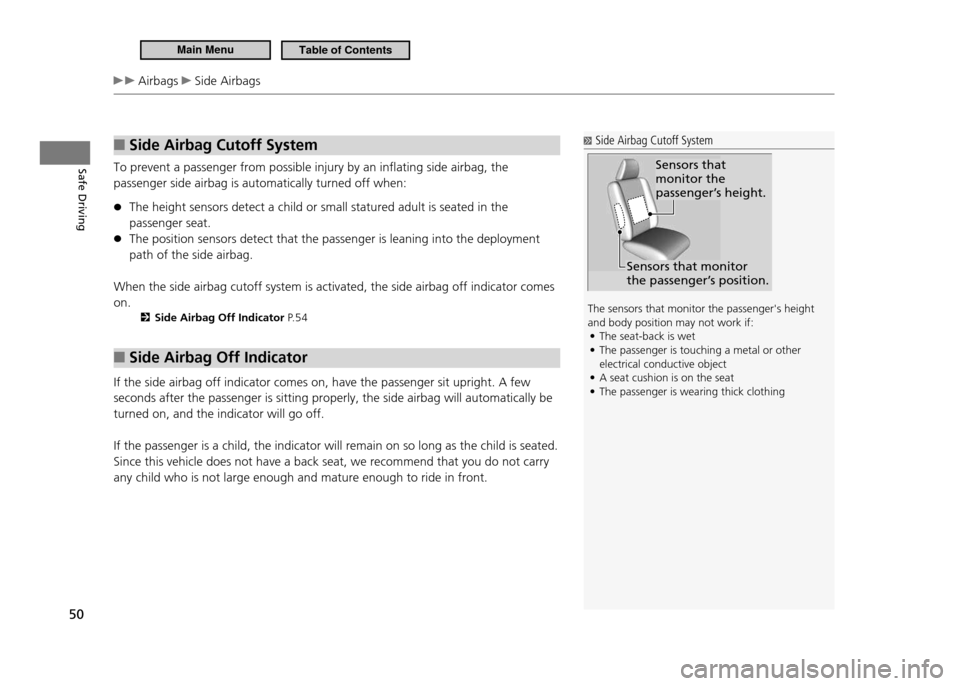
Safe Driving
50
Airbags Side Airbags
Side Airbag Cutoff System
■
To prevent a passenger from possible injury by an inflating side airbag, the passenger side airbag is automatically turned off when:
The height sensors detect a child or small statured adult is seated in the
●
passenger seat.The position sensors detect that the passenger is leaning into the deployment
●
path of the side airbag.
When the side airbag cutoff system is activated, the side airbag off indicator comes on.
Side Airbag Off Indicator P. 5 4
Side Airbag Off Indicator
■
If the side airbag off indicator comes on, have the passenger sit upright. A few seconds after the passenger is sitting properly, the side airbag will automatically be turned on, and the indicator will go off. If the passenger is a child, the indicator will remain on so long as the child is seated. Since this vehicle does not have a back seat, we recommend that you do not carry any child who is not large enough and mature enough to ride in front.
Side Airbag Cutoff System
The sensors that monitor the passenger's height and body position may not work if: The seat-back is wet
•
The passenger is touching a metal or other
•
electrical conductive objectA seat cushion is on the seat
•
The passenger is wearing thick clothing
•
Sensors that monitor the
passenger’s height.
Sensors that monitor
the passenger’s position.
Main MenuTable of Contents
Page 52 of 333
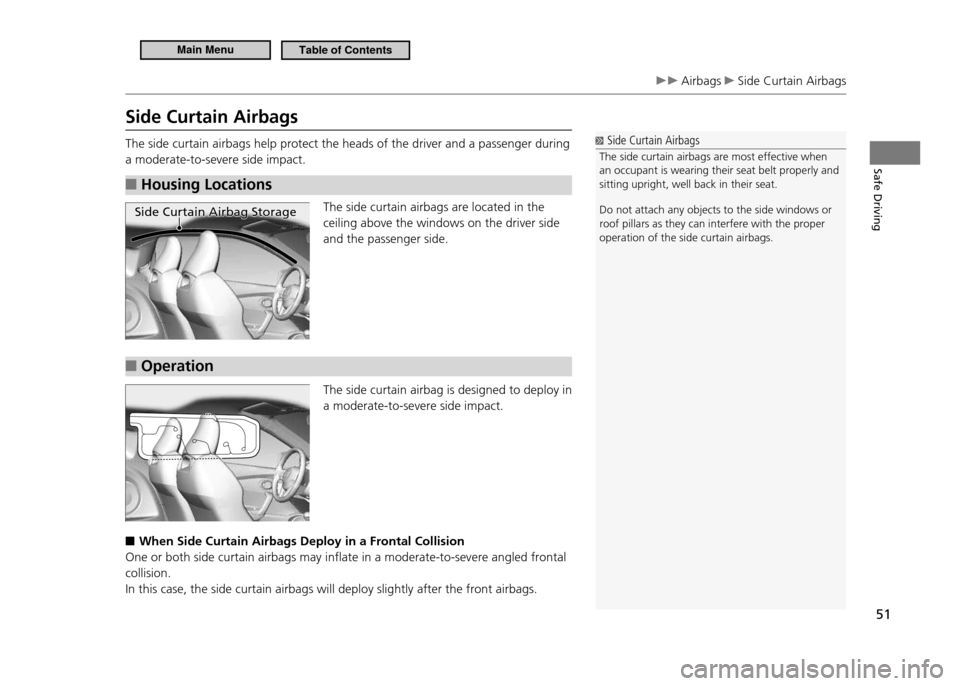
Safe Driving
51
Airbags Side Curtain Airbags
Side Curtain Airbags
The side curtain airbags help protect the heads of the driver and a passenger during a moderate-to-severe side impact.Housing Locations
■
The side curtain airbags are located in the ceiling above the windows on the driver side and the passenger side.
Operation
■
The side curtain airbag is designed to deploy in a moderate-to-severe side impact.
When Side Curtain Airbags Deploy in a Frontal Collision
■
One or both side curtain airbags may inflate in a moderate-to-severe angled frontal collision.In this case, the side curtain airbags will deploy slightly after the front airbags.
Side Curtain Airbags
The side curtain airbags are most effective when an occupant is wearing their seat belt properly and sitting upright, well back in their seat. Do not attach any objects to the side windows or roof pillars as they can interfere with the proper operation of the side curtain airbags.
Side Curtain Airbag StorageSide Curtain Airbag Storage
Main MenuTable of Contents
Page 53 of 333
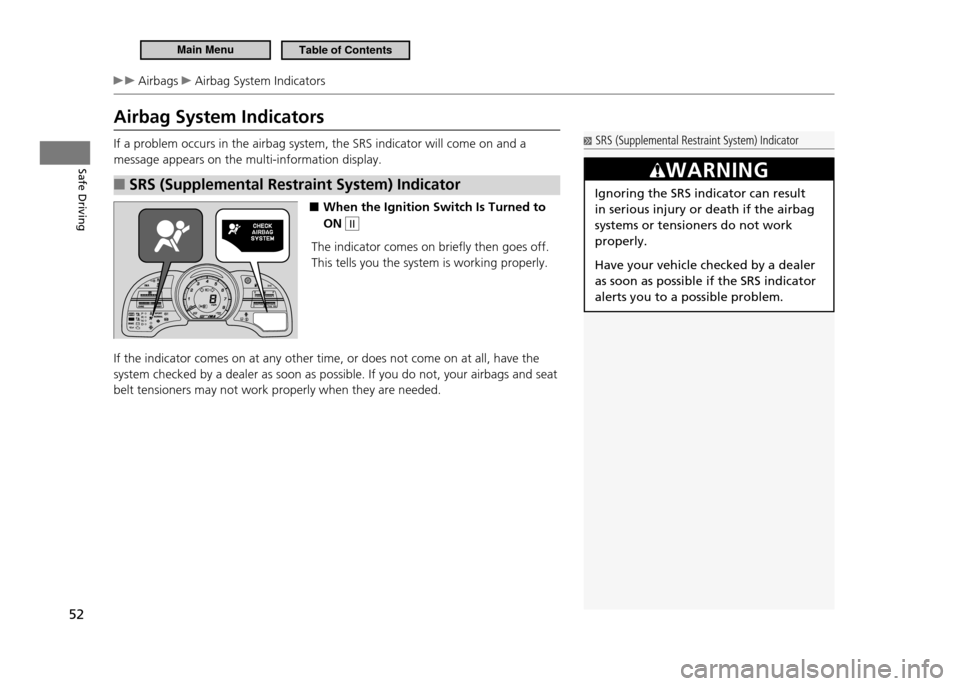
Safe Driving
52
Airbags Airbag System Indicators
Airbag System Indicators
If a problem occurs in the airbag system, the SRS indicator will come on and a message appears on the multi-information display.SRS (Supplemental Restraint System) Indicator
■
■ When the Ignition Switch Is Turned to ON
II
The indicator comes on briefly then goes off. This tells you the system is working properly.
If the indicator comes on at any other time, or does not come on at all, have the system checked by a dealer as soon as possible. If you do not, your airbags and seat belt tensioners may not work properly when they are needed.
SRS (Supplemental Restraint System) Indicator
WARNING
Ignoring the SRS indicator can result in serious injury or death if the airbag systems or tensioners do not work properly. Have your vehicle checked by a dealer as soon as possible if the SRS indicator alerts you to a possible problem.
Main MenuTable of Contents
Page 54 of 333
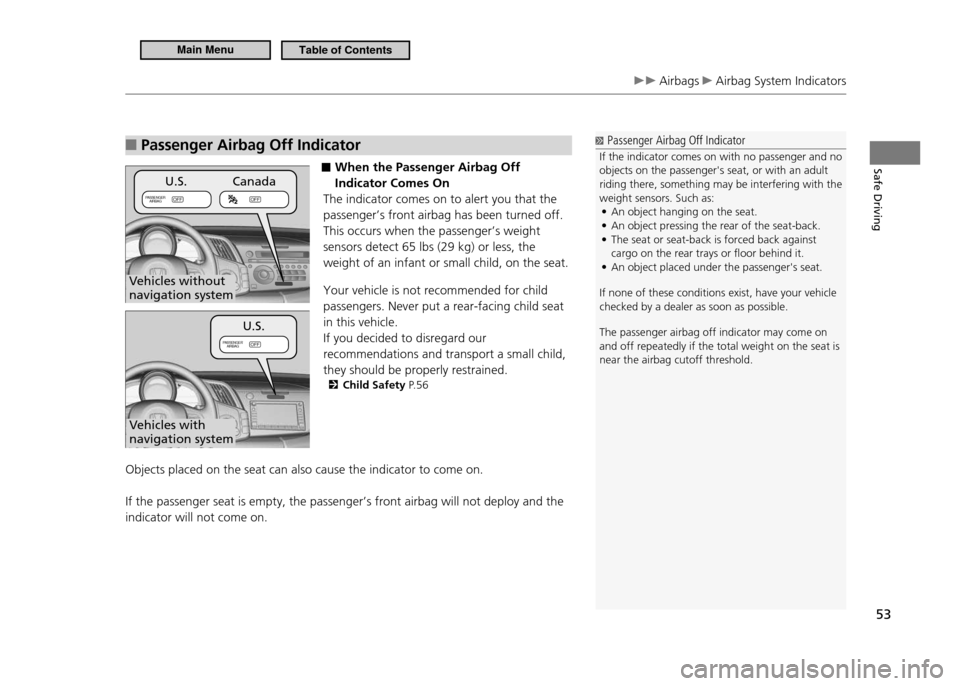
Safe Driving
53
Airbags Airbag System Indicators
Passenger Airbag Off Indicator
■
■ When the Passenger Airbag Off Indicator Comes On
The indicator comes on to alert you that the passenger’s front airbag has been turned off.This occurs when the passenger’s weight sensors detect 65 lbs (29 kg) or less, the weight of an infant or small child, on the seat. Your vehicle is not recommended for child passengers. Never put a rear-facing child seat in this vehicle.If you decided to disregard our recommendations and transport a small child, they should be properly restrained.
Child Safety P. 5 6
Objects placed on the seat can also cause the indicator to come on. If the passenger seat is empty, the passenger’s front airbag will not deploy and the indicator will not come on.
Passenger Airbag Off Indicator
If the indicator comes on with no passenger and no objects on the passenger's seat, or with an adult riding there, something may be interfering with the weight sensors. Such as: An object hanging on the seat.
•
An object pressing the rear of the seat-back.
•
The seat or seat-back is forced back against
•
cargo on the rear trays or loor behind it.An object placed under the passenger's seat.
•
If none of these conditions exist, have your vehicle checked by a dealer as soon as possible. The passenger airbag off indicator may come on and off repeatedly if the total weight on the seat is near the airbag cutoff threshold.
OFFOF F
P
ASSENGER
AIRBAG U.S. Canada
Vehicles without navigation system
OF
F
P
ASSENGER
AIRBAG
U.S.
Vehicles with navigation system
Main MenuTable of Contents
Page 55 of 333
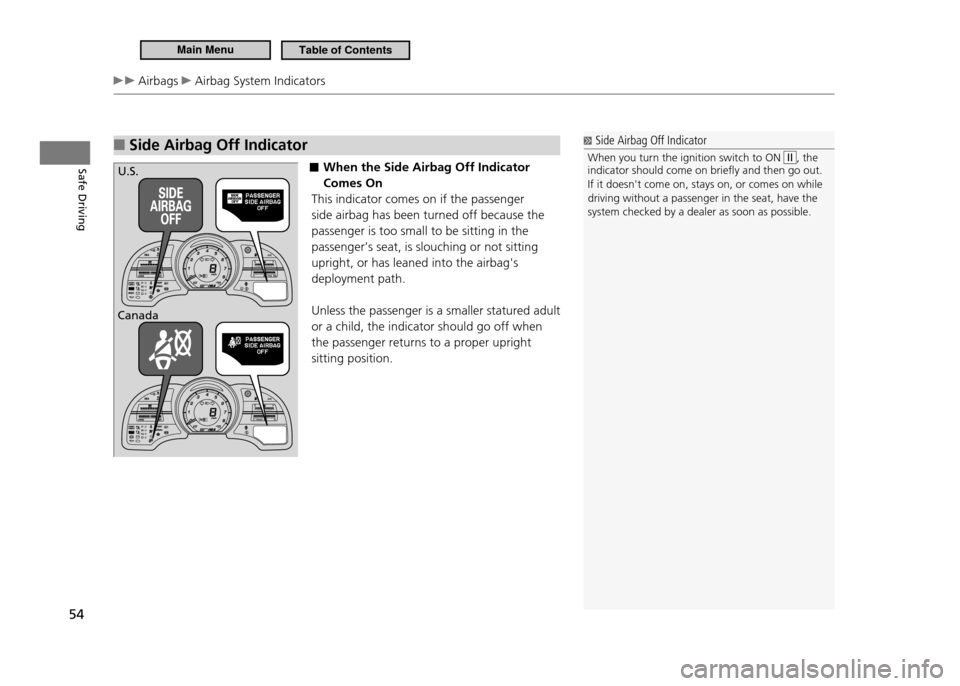
Safe Driving
54
Airbags Airbag System Indicators
Side Airbag Off Indicator
■
■ When the Side Airbag Off Indicator Comes On
This indicator comes on if the passenger side airbag has been turned off because the passenger is too small to be sitting in the passenger’s seat, is slouching or not sitting upright, or has leaned into the airbag's deployment path.
Unless the passenger is a smaller statured adult or a child, the indicator should go off when the passenger returns to a proper upright sitting position.
Side Airbag Off Indicator
When you turn the ignition switch to ON
, the
indicator should come on briely and then go out. If it doesn't come on, stays on, or comes on while driving without a passenger in the seat, have the system checked by a dealer as soon as possible.
U.S.
Canada
Main MenuTable of Contents
Page 56 of 333
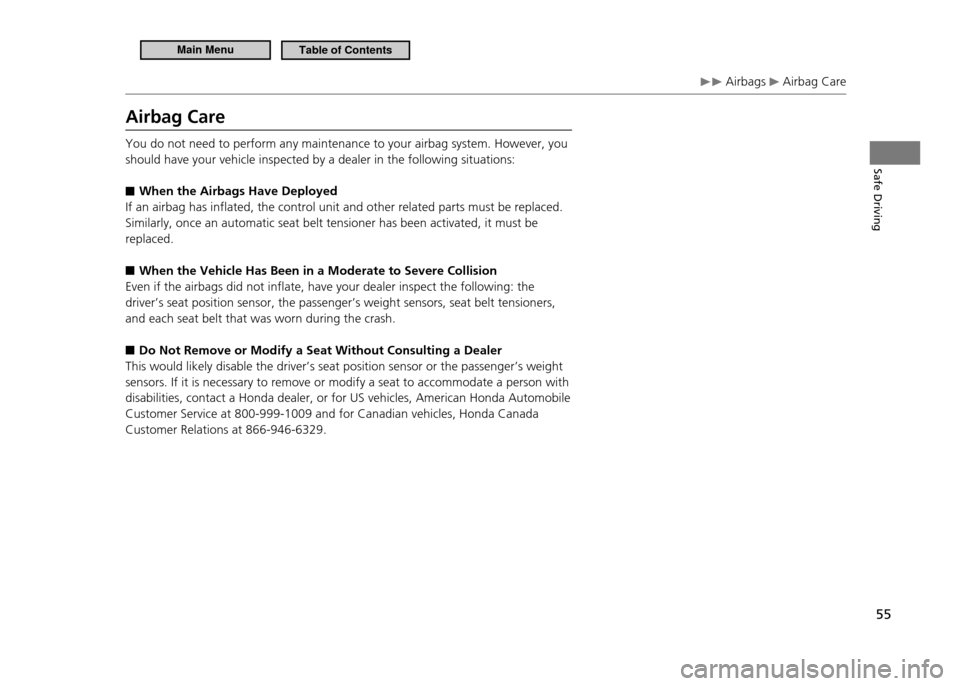
Safe Driving
55
Airbags
Airbag Care
Airbag Care You do not need to perform any maintenance to your airbag system. However, you should have your vehicle inspected by a dealer in the following situations:
When the Airbags Have Deployed
■
If an airbag has inflated, the control unit and other related parts must be replaced. Similarly, once an automatic seat belt tensioner has been activated, it must be replaced.
When the Vehicle Has Been in a Moderate to Severe Collision
■
Even if the airbags did not inflate, have your dealer inspect the following: the driver’s seat position sensor, the passenger’s weight sensors, seat belt tensioners, and each seat belt that was worn during the crash.
Do Not Remove or Modify a Seat Without Consulting a Dealer
■
This would likely disable the driver’s seat position sensor or the passenger’s weight sensors. If it is necessary to remove or modify a seat to accommodate a person with disabilities, contact a Honda dealer, or for US vehicles, American Honda Automobile Customer Service at 800-999-1009 and for Canadian vehicles, Honda Canada Customer Relations at 866-946-6329.
Main MenuTable of Contents
Page 57 of 333
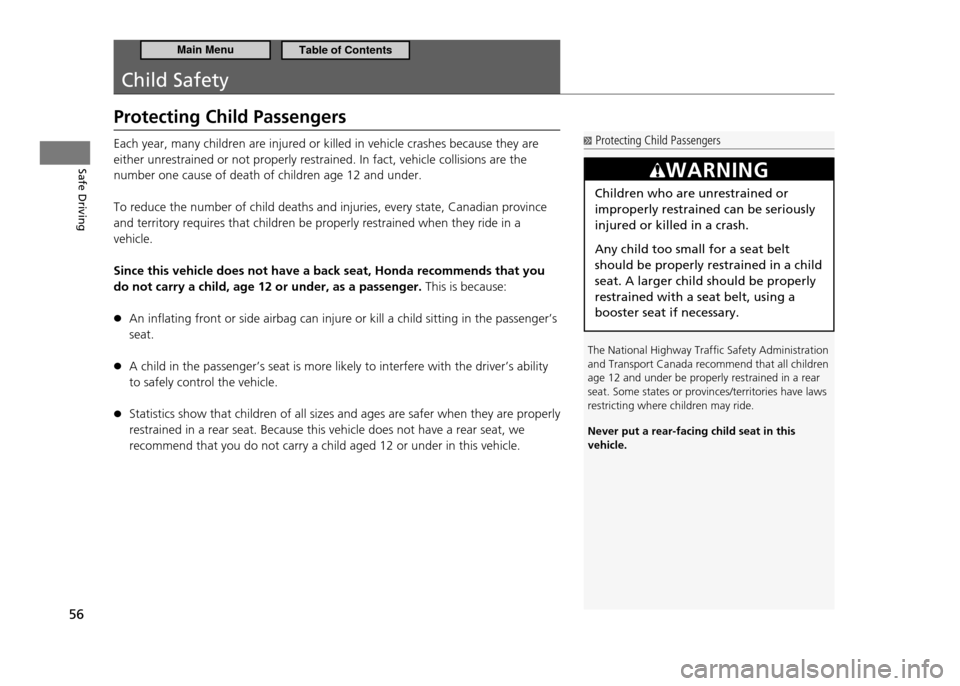
56
Safe Driving
Child Safety
Protecting Child Passengers Each year, many children are injured or killed in vehicle crashes because they are either unrestrained or not properly restrained. In fact, vehicle collisions are the number one cause of death of children age 12 and under. To reduce the number of child deaths and injuries, every state, Canadian province and territory requires that children be properly restrained when they ride in a vehicle. Since this vehicle does not have a back seat, Honda recommends that you do not carry a child, age 12 or under, as a passenger. This is because:
An inflating front or side airbag can injure or kill a child sitting in the passenger’s
●
seat. A child in the passenger’s seat is more likely to interfere with the driver’s ability
●
to safely control the vehicle.
Statistics show that children of all sizes and ages are safer when they are properly
●
restrained in a rear seat. Because this vehicle does not have a rear seat, we recommend that you do not carry a child aged 12 or under in this vehicle.
Protecting Child Passengers
The National Highway Trafic Safety Administration and Transport Canada recommend that all children age 12 and under be properly restrained in a rear seat. Some states or provinces/territories have laws restricting where children may ride. Never put a rear-facing child seat in this vehicle.
WARNING
Children who are unrestrained or improperly restrained can be seriously injured or killed in a crash. Any child too small for a seat belt should be properly restrained in a child seat. A larger child should be properly restrained with a seat belt, using a booster seat if necessary.
Main MenuTable of Contents
Page 58 of 333
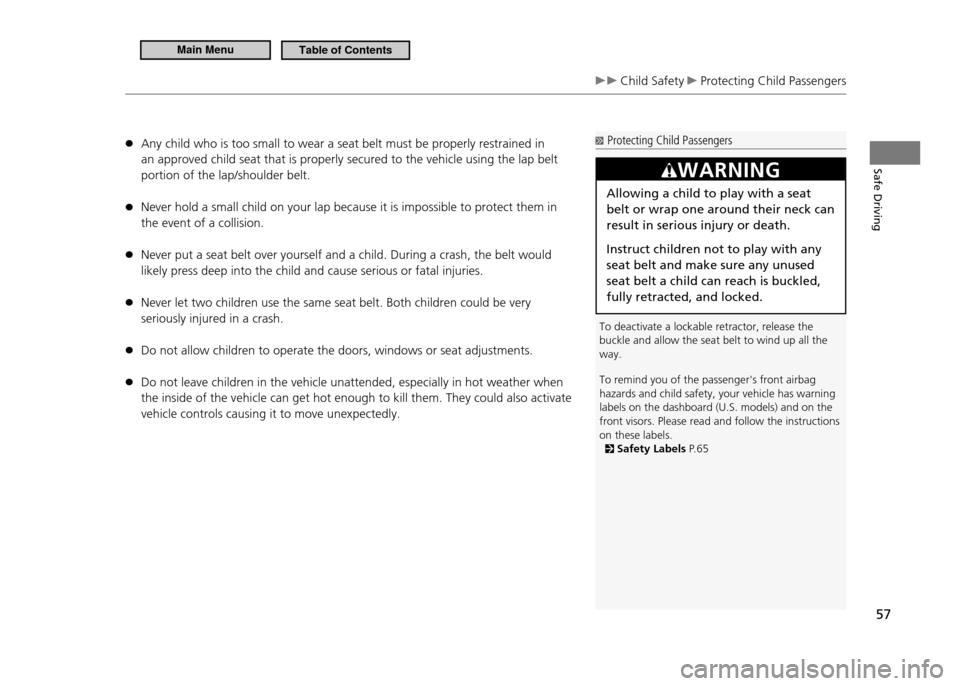
Safe Driving
57
Child Safety Protecting Child Passengers
Any child who is too small to wear a seat belt must be properly restrained in
●
an approved child seat that is properly secured to the vehicle using the lap belt portion of the lap/shoulder belt. Never hold a small child on your lap because it is impossible to protect them in
●
the event of a collision.Never put a seat belt over yourself and a child. During a crash, the belt would
●
likely press deep into the child and cause serious or fatal injuries.Never let two children use the same seat belt. Both children could be very
●
seriously injured in a crash.Do not allow children to operate the doors, windows or seat adjustments.
●
Do not leave children in the vehicle unattended, especially in hot weather when
●
the inside of the vehicle can get hot enough to kill them. They could also activate vehicle controls causing it to move unexpectedly.
Protecting Child Passengers
To deactivate a lockable retractor, release the buckle and allow the seat belt to wind up all the way. To remind you of the passenger's front airbag hazards and child safety, your vehicle has warning labels on the dashboard (U.S. models) and on the front visors. Please read and follow the instructions on these labels.
Safety Labels P. 6 5
WARNING
Allowing a child to play with a seat belt or wrap one around their neck can result in serious injury or death. Instruct children not to play with any seat belt and make sure any unused seat belt a child can reach is buckled, fully retracted, and locked.
Main MenuTable of Contents
Page 59 of 333
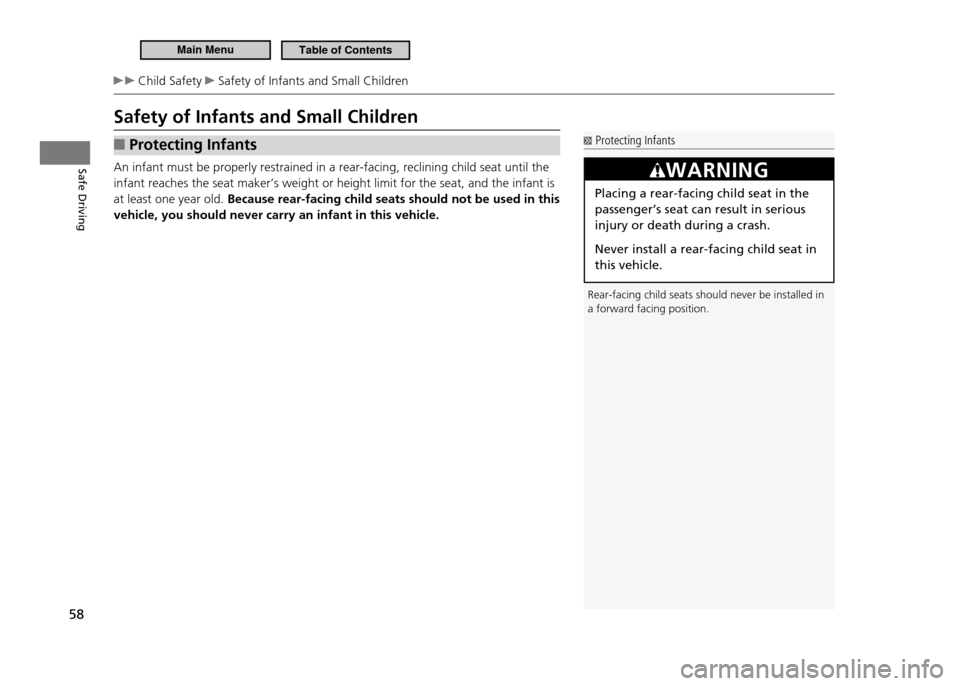
Safe Driving
58
Child Safety Safety of Infants and Small Children
Safety of Infants and Small Children
Protecting Infants
■
An infant must be properly restrained in a rear-facing, reclining child seat until the infant reaches the seat maker’s weight or height limit for the seat, and the infant is at least one year old. Because rear-facing child seats should not be used in this
vehicle, you should never carry an infant in this vehicle.
Protecting Infants
Rear-facing child seats should never be installed in a forward facing position.
WARNING
Placing a rear-facing child seat in the passenger’s seat can result in serious injury or death during a crash. Never install a rear-facing child seat in this vehicle.
Main MenuTable of Contents
Page 60 of 333
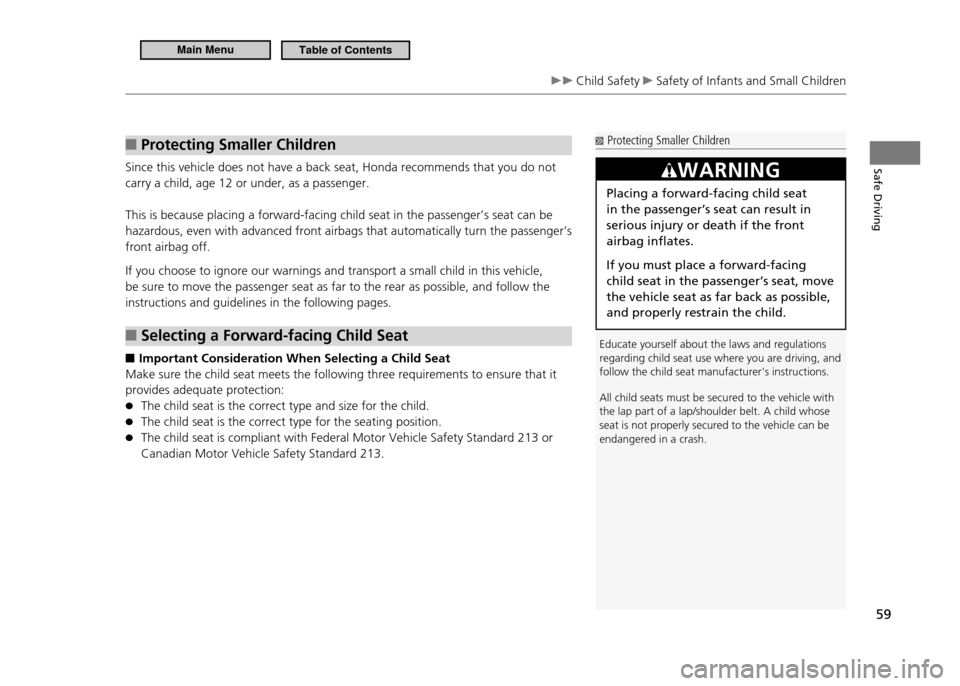
Safe Driving
59
Child Safety Safety of Infants and Small Children
Protecting Smaller Children
■
Since this vehicle does not have a back seat, Honda recommends that you do not carry a child, age 12 or under, as a passenger. This is because placing a forward-facing child seat in the passenger’s seat can be
hazardous, even with advanced front airbags that automatically turn the passenger’s front airbag off. If you choose to ignore our warnings and transport a small child in this vehicle, be sure to move the passenger seat as far to the rear as possible, and follow the instructions and guidelines in the following pages.
Selecting a Forward-facing Child Seat
■
Important Consideration When Selecting a Child Seat
■
Make sure the child seat meets the following three requirements to ensure that it provides adequate protection:
The child seat is the correct type and size for the child.
●
The child seat is the correct type for the seating position.
●
The child seat is compliant with Federal Motor Vehicle Safety Standard 213 or
●
Canadian Motor Vehicle Safety Standard 213.
Protecting Smaller Children
Educate yourself about the laws and regulations regarding child seat use where you are driving, and follow the child seat manufacturer's instructions. All child seats must be secured to the vehicle with the lap part of a lap/shoulder belt. A child whose seat is not properly secured to the vehicle can be endangered in a crash.
WARNING
Placing a forward-facing child seat in the passenger’s seat can result in serious injury or death if the front airbag inflates. If you must place a forward-facing child seat in the passenger’s seat, move the vehicle seat as far back as possible, and properly restrain the child.
Main MenuTable of Contents